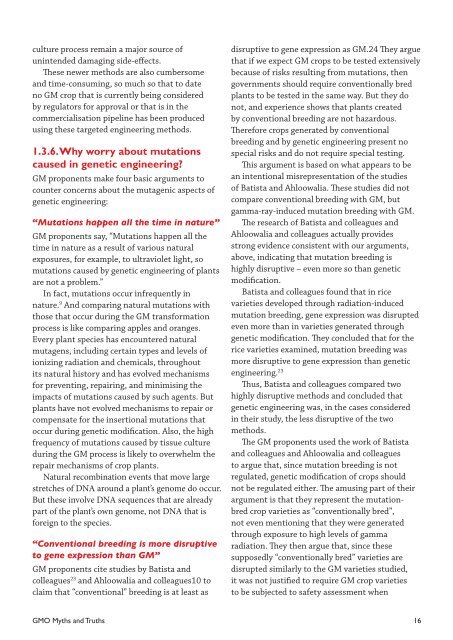GMO Myths and Truths
GMO Myths and Truths
GMO Myths and Truths
Create successful ePaper yourself
Turn your PDF publications into a flip-book with our unique Google optimized e-Paper software.
culture process remain a major source of<br />
unintended damaging side-effects.<br />
These newer methods are also cumbersome<br />
<strong>and</strong> time-consuming, so much so that to date<br />
no GM crop that is currently being considered<br />
by regulators for approval or that is in the<br />
commercialisation pipeline has been produced<br />
using these targeted engineering methods.<br />
1.3.6. Why worry about mutations<br />
caused in genetic engineering?<br />
GM proponents make four basic arguments to<br />
counter concerns about the mutagenic aspects of<br />
genetic engineering:<br />
“Mutations happen all the time in nature”<br />
GM proponents say, “Mutations happen all the<br />
time in nature as a result of various natural<br />
exposures, for example, to ultraviolet light, so<br />
mutations caused by genetic engineering of plants<br />
are not a problem.”<br />
In fact, mutations occur infrequently in<br />
nature. 9 And comparing natural mutations with<br />
those that occur during the GM transformation<br />
process is like comparing apples <strong>and</strong> oranges.<br />
Every plant species has encountered natural<br />
mutagens, including certain types <strong>and</strong> levels of<br />
ionizing radiation <strong>and</strong> chemicals, throughout<br />
its natural history <strong>and</strong> has evolved mechanisms<br />
for preventing, repairing, <strong>and</strong> minimising the<br />
impacts of mutations caused by such agents. But<br />
plants have not evolved mechanisms to repair or<br />
compensate for the insertional mutations that<br />
occur during genetic modification. Also, the high<br />
frequency of mutations caused by tissue culture<br />
during the GM process is likely to overwhelm the<br />
repair mechanisms of crop plants.<br />
Natural recombination events that move large<br />
stretches of DNA around a plant’s genome do occur.<br />
But these involve DNA sequences that are already<br />
part of the plant’s own genome, not DNA that is<br />
foreign to the species.<br />
“Conventional breeding is more disruptive<br />
to gene expression than GM”<br />
GM proponents cite studies by Batista <strong>and</strong><br />
colleagues 23 <strong>and</strong> Ahloowalia <strong>and</strong> colleagues10 to<br />
claim that “conventional” breeding is at least as<br />
disruptive to gene expression as GM.24 They argue<br />
that if we expect GM crops to be tested extensively<br />
because of risks resulting from mutations, then<br />
governments should require conventionally bred<br />
plants to be tested in the same way. But they do<br />
not, <strong>and</strong> experience shows that plants created<br />
by conventional breeding are not hazardous.<br />
Therefore crops generated by conventional<br />
breeding <strong>and</strong> by genetic engineering present no<br />
special risks <strong>and</strong> do not require special testing.<br />
This argument is based on what appears to be<br />
an intentional misrepresentation of the studies<br />
of Batista <strong>and</strong> Ahloowalia. These studies did not<br />
compare conventional breeding with GM, but<br />
gamma-ray-induced mutation breeding with GM.<br />
The research of Batista <strong>and</strong> colleagues <strong>and</strong><br />
Ahloowalia <strong>and</strong> colleagues actually provides<br />
strong evidence consistent with our arguments,<br />
above, indicating that mutation breeding is<br />
highly disruptive – even more so than genetic<br />
modification.<br />
Batista <strong>and</strong> colleagues found that in rice<br />
varieties developed through radiation-induced<br />
mutation breeding, gene expression was disrupted<br />
even more than in varieties generated through<br />
genetic modification. They concluded that for the<br />
rice varieties examined, mutation breeding was<br />
more disruptive to gene expression than genetic<br />
engineering. 23<br />
Thus, Batista <strong>and</strong> colleagues compared two<br />
highly disruptive methods <strong>and</strong> concluded that<br />
genetic engineering was, in the cases considered<br />
in their study, the less disruptive of the two<br />
methods.<br />
The GM proponents used the work of Batista<br />
<strong>and</strong> colleagues <strong>and</strong> Ahloowalia <strong>and</strong> colleagues<br />
to argue that, since mutation breeding is not<br />
regulated, genetic modification of crops should<br />
not be regulated either. The amusing part of their<br />
argument is that they represent the mutationbred<br />
crop varieties as “conventionally bred”,<br />
not even mentioning that they were generated<br />
through exposure to high levels of gamma<br />
radiation. They then argue that, since these<br />
supposedly “conventionally bred” varieties are<br />
disrupted similarly to the GM varieties studied,<br />
it was not justified to require GM crop varieties<br />
to be subjected to safety assessment when<br />
<strong>GMO</strong> <strong>Myths</strong> <strong>and</strong> <strong>Truths</strong> 16


